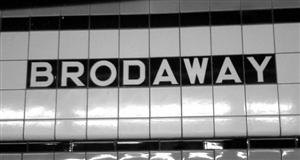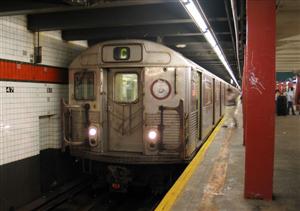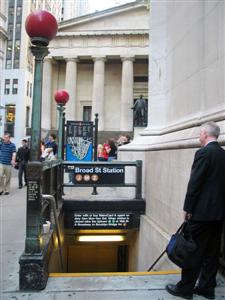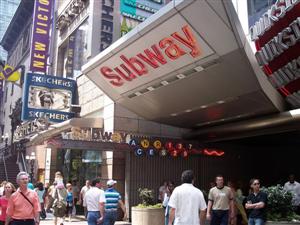May 2010 TRUCKER TALK
GOING UNDERNEATH NEW YORK
BY WRITER & DRIVER KIM GRIMM
The New York City subway system is one of the oldest and most extensive public transportation systems in the world. About 40% of the New York City subways run on surface or elevated tracks, while the other 60% run underground. This huge transit system has 468 stations and 842 total miles of track. In 2008, the subway delivered over 1.6 billion rides, averaging over five million a day on weekdays, 2.9 million on Saturdays, and 2.3 million on Sundays. With this kind of volume, the NYC subway trails only Tokyo’s, Moscow’s and Seoul’s subways in annual ridership. The subway system is owned by the City of New York and leased to the New York City Transit Authority, a subsidiary agency of the Metropolitan Transportation Authority, also known as MTA New York City Transit.
A demonstration for an underground transit system in NYC was first built in 1869 by Alfred Ely Beach. His Beach Pneumatic Transit extended 312 feet under Broadway in Lower Manhattan and exhibited his idea for a subway propelled by pneumatic tube technology. The tunnel was never extended for political and financial reasons, and later demolished, but it did pave the way for below-ground trains. A heavy snowstorm in 1888 also helped to convince the people of the benefits of an underground transportation system, and in 1904 the first underground line of the subway opened, almost 35 years after the opening of the first elevated line in NYC, which became the IRT (Interborough Rapid Transit) Ninth Avenue Line. The IRT expanded out to the Bronx in 1905, then on to Brooklyn in 1908. Expansion to the Queens Borough occurred in 1915, and then the BMT (Brooklyn-Manhattan Transit Company) took over the BRT (Brooklyn Rapid Transit) a few years later.
 It was freely prophesied when the plans for the underground subway were completed and the asking of bids advertised, that there would be no bidders, and even if it was built, it would be a failure. I guess we can see just how very wrong those who doubted the system’s importance really were. The old Rapid Transit Board that planned New York’s first underground road was passed out of existence through an act of the legislature before the gigantic undertaking it had planned was finished. In 1904, the tunnel construction used was the “cut and cover” method – the street was torn up, the tunnel dug, and then the street was rebuilt above. For sections with thicker portions of bedrock, boring machines were needed. Once the underground roads were completed, residents quickly forgot about all the troubles that were caused while building them.
It was freely prophesied when the plans for the underground subway were completed and the asking of bids advertised, that there would be no bidders, and even if it was built, it would be a failure. I guess we can see just how very wrong those who doubted the system’s importance really were. The old Rapid Transit Board that planned New York’s first underground road was passed out of existence through an act of the legislature before the gigantic undertaking it had planned was finished. In 1904, the tunnel construction used was the “cut and cover” method – the street was torn up, the tunnel dug, and then the street was rebuilt above. For sections with thicker portions of bedrock, boring machines were needed. Once the underground roads were completed, residents quickly forgot about all the troubles that were caused while building them.
In the beginning, both of the BMT and IRT systems were privately owned. But, the city was still closely involved – all lines built for the IRT and most other lines built or improved after 1913 were built by the city and leased to the companies. The first line of the city-owned and operated Independent Subway System (IND) opened in 1932. Then, in 1940, the city purchased the IRT and BMT and made New York City the sole owner operator of all the subways and railways in the city.
Passengers originally paid for a ride on the subway with a ticket. It wasn’t until the 1920’s when coin-operated turnstiles were introduced. From the opening in 1904 until July 1, 1948, the fare for a ride of any length on the subway was a nickel. On that day in 1948, the fare was increased to a dime. On June 15, 1953, the day that the NYC Transit Authority was created, the fare was raised to 15 cents and a token was issued because the turnstiles couldn’t accommodate two coins. In 1994, the MTA introduced a new, more convenient, fare system called the MetroCard, which allowed riders to use special plastic cards that would store the value equal to the amount paid to a station booth clerk or to a vending machine. The last day tokens were accepted, after nearly 50 years, was April 13, 2003.
 At the top of most of the system’s subway stations sits a lamp post or two bearing a colored spherical lamp. Before the introduction of the MetroCard in 1994, these lights indicated the station’s availability. A green lamp meant that the station was open and running 24 hours a day, a yellow lamp meant that it was open only during the day, while a red lamp meant that it was an exit only. The yellow lamps were eventually phased out and replaced with red lamps. Today, this color system uses green lamps to indicate 24-hour entrances and red lamps to indicate non 24-hour entrances.
At the top of most of the system’s subway stations sits a lamp post or two bearing a colored spherical lamp. Before the introduction of the MetroCard in 1994, these lights indicated the station’s availability. A green lamp meant that the station was open and running 24 hours a day, a yellow lamp meant that it was open only during the day, while a red lamp meant that it was an exit only. The yellow lamps were eventually phased out and replaced with red lamps. Today, this color system uses green lamps to indicate 24-hour entrances and red lamps to indicate non 24-hour entrances.
Many of the stations are decorated with intricate ceramic tile artwork – some of it dates back to 1904 when the subway first opened for business. Today, the “Arts for Transit” program continues that tradition and oversees all of the art within the subway system. There are some permanent installations like sculptures, mosaics and murals, as well as temporary exhibits featuring photography, poetry and music. One funny side note, in regards to the tile work, is that there are all sorts of errors throughout the subway system. Outdated signs (and signs that were never correct in the first place) abound, with the most famous of these errors being the misspelling of Broadway as “Brodaway” for all to see.
Since 1982, the MTA has sponsored the “Music Under New York” (MUNY) program in which street musicians enter a competitive contest to be assigned to perform in the preferred high-traffic locations. The MUNY program provides over 150 weekly performances at 25 locations. It is a First Amendment right and part of the MTA policy that any musician/performer may perform on subway mezzanines and platforms, as long as they adhere to a list of restrictions, mostly regarding volume and locations. The day I got to ride the subway last September, one of these street musicians was down in the station singing Amazing Grace. Let me tell you, the sound of that man’s voice, echoing through the subway halls, gave me chills.
Within the subway system, routings change often. “Routes” (also called “services”) are distinguished by a letter or number, while “lines” have names. There are 26 train services in the subway, including three short shuttles. Each route has its own color designation, representing the Manhattan trunk line of the particular service, and is labeled as local or express. A separate color is assigned to the Crosstown Line route, since it operates entirely outside of Manhattan, and the shuttles are all assigned dark gray. Each service is also named after its Manhattan (or crosstown) trunk line. As you can see, the NYC subway is perhaps the most complex metro system in the world.
 The current color system depicted on official subway maps was proposed by R. Raleigh D’Adamo, a lawyer who entered a contest sponsored by the Transit Authority in 1964. D’Adamo proposed replacing a map that used only three colors (which represented the three operating entities of the subway network) with a map that used a different color for each line. D’Adamo’s contest entry shared first place with two others and led the Transit Authority to adopt a multi-colored scheme.
The current color system depicted on official subway maps was proposed by R. Raleigh D’Adamo, a lawyer who entered a contest sponsored by the Transit Authority in 1964. D’Adamo proposed replacing a map that used only three colors (which represented the three operating entities of the subway network) with a map that used a different color for each line. D’Adamo’s contest entry shared first place with two others and led the Transit Authority to adopt a multi-colored scheme.
Crime is one of the problems that the subway has had to deal with over the years. Many riders abandoned the subways when crime and graffiti became prevalent in the 1980’s. When Mayor Rudy Giuliani took office in 1993, he adopted a strict “zero tolerance” policy for crime in the subway, causing crime rates to drop dramatically. When I rode the subway, I did not feel scared or vulnerable at all – it was a good experience. In a 2004 press release, Mayor Michael Bloomberg stated, “Today the subway system is safer than it has been at any time since we started tabulating subway crime statistics nearly 40 years ago.” Rats, flooding, suicides and overcrowding are some of the other problems that the MTA has had to deal with over the years.
The NYC subway system has done more than just move people around – it has become an American institution and has even influenced our favorite pastime – baseball – a time or two. Most of you probably know that the Major League Baseball team in Los Angeles is called the Dodgers, and that they were originally from Brooklyn, but do you know where the name came from? Well, the baseball fans in Brooklyn had to cross several sets of subway train tracks to get to the ball field and subsequently “dodge” the trolleys. Before they were called the Brooklyn Dodgers, they were known as the Trolley Dodgers. Also, whenever the New York Yankees and New York Mets play in the World Series (which is not very often), they call it a “Subway Series” due to the proximity of the teams and the fact that you can ride the subway to both ball parks.
Today, the A line is the longest subway line in the world at 31 miles. In 1932, when it first opened, it was only 12 miles long. On September 10, 2007, the 75th anniversary of the A line’s opening was celebrated with a ceremony at the Inwood-27th Street station in Upper Manhattan and included a ride in six pre-WWII subway cars to Lower Manhattan. To celebrate the 100th anniversary of the first underground portion of the NYC subway system on October 27, 2004, the Transit Authority dressed in turn-of-the-century costumes to greet a crowd in City Hall Park. To give subway customers a glimpse of history, restored vintage trains were put into service throughout the system, during the day, for the rest of the year.
If you ever get the opportunity to ride on the NYC subway, I would not pass it up. Walking through the halls and looking at how it all works, it’s hard to believe that the system has been around for over 100 years. Taking the subway in NYC is cheap, easy, convenient and fun – and, if you are just a tourist like I was, it is memorable, too. I could not imagine how much worse the traffic on the above-ground streets would be if there wasn’t this vast network of “underground roads” lying beneath this enormously crowded city. And if you ever needed to get somewhere in a hurry – you could just fugeddaboutit!
